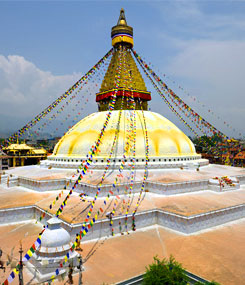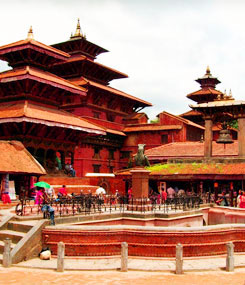Nepal Tour
Duration : 03 Nights / 04 Days
Destination : Kathmandu
Arrive at the international airport in Kathmandu. Meeting and assistance at the airport and transfer to hotel. Rest of the day at leisure. Overnight at hotel.
Day 02 : KathmanduKathmandu City : Here you will visit the temple of the Living Goddess, who acknowledges the greetings of the devotees from the balcony of her temple residence. Kasthamandap – the source of the name Kathmandu and supposed to be made from the timber of a single tree and Durbar Square are with its array of temples overlooked by the Hanuman Dhoka Palace, the ancient residence of the Nepalese Royalty.
The Kumari Goddess : Chosen at the age of four or five, the Kumari Devi is the most important of the several living goddesses in Nepal, selected using very strict criteria, she moves into the temple with her family, leaving only to attain a few festivals each year. She sits on the balcony regularly, acknowledging the greetings of devotees. Her reign however lasts only until puberty, when she becomes a normal mortal again.

Swayambhunath Stupa, kathmandu
Swayambhunath : Perched on a hilltop on the southwestern part of Kathmandu, Swayambhunath is one of the most important religious and cultural sites in Nepal and is associated with the birth of the Kathmandu Valley civilization. Approximately 2000 years old, Swayambhunath stupa, is a dome 20 meters in diameter and 32 meters high and is made of brick and earth mounted by a conical spire capped by a pinnacle of copper gilt. Many other smaller temples and places of religious importance for both Hindus and Buddhists, a perfect example of the symbiotic co-existence of different religious beliefs only found in Nepal surround it. The hill is heavily wooded on all sides with indigenous plant species, and troops of monkeys, giving it the nickname of "Monkey Temple". The height of Swayambhunath also makes it a good vantage point and on clear sunny days one can see the Himalayas all the way to the east.
Patan or Yala : Patan as it is known today is located on the southern banks of the Bagmati River and is one of the three main cities in Kathmandu Valley. The city is believed to be the first settlement in the Valley and was established by the Kirat dynasty who ruled for more than 1200 years from the 3rd century BC. Patan is famous for its amazing collection of fantastically carved temples, palace courtyards, water spouts, public baths and houses with their equally elaborate wood, stone and metal carvings under the patronages of the Kirat, Lichivi and Malla kings. Patan has more than a 1000 temples and monuments dedicated to the uniquely Nepali mix of Buddhist and Hindu gods, chief among which are the mounds erected by the great Indian Emperor Asoka in the four corners of the city when he visited Nepal in 250 BC. Patan Durbar square is one of the seven Monument Zones that make up the Kathmandu Valley UNESCO World Heritage Site.
Overnight at the hotel.
Pashupatinath : The temple of Pashupatinath located on the western banks of the Bagmati river on the north eastern side of Kathmandu, is one of the most important Hindu pilgrimage site in the world. Until recently Nepal was officially a Hindu Kingdom and Pashupatinath, which literally means "Lord of all Animals", was considered the main protector deity of Nepal. Pashupatinath is said to have been discovered by a cow herder who dug up the area after seeing one of his cow's coming to the spot and emptying its milk there. The inner sanctum of the temple has a lingam, a stone phallus with four faces around it. As one of the many forms of Lord Shiva, one of the three main gods of the Hindu Trinity, Pashupatinath draws Hindu pilgrims from all around the world especially on MahaShivaratri, the "Night of Shiva" which falls in early spring. The temple and its surrounding complex is surrounded by a pantheon of other temples like the Kirateswore Mahadev, Bhairav, Guheswori and Gorakhnath each of whom have their own tale of origin and importance. Pashupatinath is also a UNESCO World Heritage Site.
Bouddhanath : With a base of 82 meters in diameter, Bouddhanath is claimed to be the largest Buddhist stupa in the world. There are many legends attached to Bouddhanath, chief among which is that of the 5th century Lichivi King Manadev who built it to do penance. Lost and forgotten for centuries Bouddhanath was rediscovered in the 15th century from whence it slowly started gaining reputation among Tibetan Buddhists especially after the 19th century Rana Prime Minister appointed a Tibetan monk as its chief abbot. Today there are more than 50 monasteries surrounding Bouddhanath which is also one of the seven Monument Zones which make up the Kathmandu Valley World Heritage Sites.

Bhaktapur Durber Square, Kathmandu
Bhaktapur : One of the three main cities in the Valley, Bhaktapur is located east of Kathmandu and is in reality a medieval city where the Newars, the main inhabitants still follow age old traditions and customs. Established around the 9th century Bhaktapur is known for its fertile land and was still a small farming village when Patan and Kathmandu were already well established towns. Bhaktapur became the capital of the Valley in 1377 BC during the reign of the Malla dynasty and flourished as a major urban centre from the 15th century onwards. It houses some of the best examples of Nepali craftsmanship on wood and stone such as the Palace of 55 Windows built in 1697, the five storied Nyatapola Temple, the Kashi Biswanath Temple, the Dattatreya Temple among many others. Considered a living museum one can witness ancient traditions carried out even today as they were centuries ago in many areas of the city such as in Potters Square where the local potters use age old techniques to make clay utensils. Bhaktapur is also among the seven Monument Zones that make the Kathmandu Valley World Heritage Sites.
Later transfer to ethnic Nepalese restaurant for cultural dance with dinner. Overnight at the hotel.
Day 04: KathmanduBreakfast in the hotel. Later in time transfer to the international airport to board the flight to onward destination.
Our Services ends here…